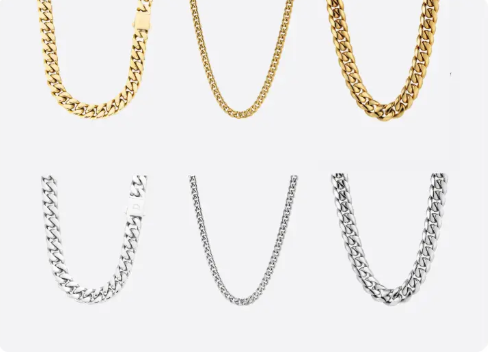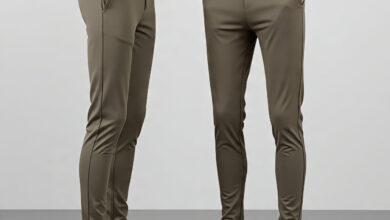From Hip-Hop Icons to Hollywood Stars: The Story Behind Cuban Chains and Tennis Bracelets

Jewelry has long been a symbol of wealth, style, and status — but few pieces carry as much cultural weight and visual impact as Cuban link chain and tennis bracelet. From the block parties of the Bronx to the red carpets of Hollywood, these two jewelry staples have traveled an extraordinary path through fashion history.
In 2025, they’re not just trending — they’ve become global style icons in their own right. Whether dripping in moissanite or worn sleek and simple, Cuban links and tennis bracelets tell a story of legacy, reinvention, and unapologetic self-expression.
Let’s take a deeper look at where they came from, who made them famous, and why they continue to dominate both hip-hop culture and high fashion.
Cuban Link Chains: Born in the Heart of Hip-Hop
The Cuban link chain was born during the golden era of hip-hop — the late 1970s to early 1980s — in places like Miami, New York, and Atlanta. It quickly became a symbol of power, success, and authenticity in rap culture.
Known for their bold, interlocking links, Cuban chains were seen as more than accessories — they were trophies earned through hustle, talent, and ambition.
Worn by Legends
- Big Daddy Kane and Slick Rick were among the early adopters, layering thick gold chains with pendants that reflected their lyrical dominance.
- Tupac Shakur was frequently photographed in Cuban chains, blending streetwear grit with poetic soul.
- Jay-Z, Nas, and Busta Rhymes carried the style into the 90s and 2000s, pushing it into mainstream visibility.
These chains became the visual soundtrack of hip-hop, often custom-made, encrusted with diamonds or moissanite, and paired with oversized medallions.
Tennis Bracelets: A Red-Carpet Origin with a Twist
The tennis bracelet has a completely different — but equally iconic — origin story. Its name was coined during the 1987 U.S. Open, when tennis star Chris Evert lost her diamond bracelet mid-match and asked officials to stop play until it was found.
Since then, the design — a continuous line of uniform stones, typically diamonds or moissanite — has become a staple of elegant, refined jewelry.
Redefined by the Spotlight
- Hollywood stars like Julia Roberts, Angelina Jolie, and Charlize Theron have long worn tennis bracelets on red carpets, award shows, and fashion campaigns.
- The bracelet became synonymous with timeless femininity — but that’s changed.
- In 2025, LeBron James, ASAP Rocky, and even Drake are rocking tennis bracelets alongside Cuban links, showing just how far the bracelet has come.
Today’s tennis bracelet is a gender-fluid piece, styled with streetwear or luxury fashion, worn solo or stacked — and always shining.
Cultural Fusion: Street Meets Elite
The crossover of these two styles — from hip-hop stages to haute couture — marks a new chapter in fashion where street culture influences luxury, not the other way around.
In this fusion:
- Cuban link chains are styled with high-end blazers and designer loafers.
- Tennis bracelets are stacked with Rolex watches and worn with graphic tees.
- Both are embraced by everyone — not just musicians and celebrities — but stylists, influencers, and fashion-forward shoppers around the world.
What was once niche is now universally admired.
Why These Styles Are Still Relevant in 2025
Several key trends and cultural shifts explain their lasting popularity:
1. Self-Expression Through Accessories
In a world that values personal identity, these pieces allow wearers to say something without speaking. Cuban links say bold and unshakable; tennis bracelets say sharp and self-aware.
2. Global Fashion Influence
No longer limited to the U.S., both designs are hot across Europe, Asia, and the Middle East — with artists and trendsetters styling them in new ways every season.
3. Sustainable, Accessible Luxury
With moissanite and lab-grown diamonds rising in popularity (25–30% annual growth), these pieces are now available at lower price points without sacrificing brilliance or quality.
4. Celebrity & Influencer Endorsements
These pieces go viral the moment they’re worn:
- Rihanna stacked moissanite tennis bracelets in a New York fashion shoot.
- Travis Scott debuted a flame-themed Cuban chain at a Paris runway show.
- Zendaya wore a minimalist tennis bracelet at the Met Gala alongside an oversized Cuban chorke.
The Modern Materials Making It Possible
In 2025, luxury isn’t just about price — it’s about intention.
That’s why modern versions of both Cuban chains and tennis bracelets often include:
- 925 sterling silver: A hypoallergenic, durable base metal
- Moissanite stones: An ethical alternative with exceptional fire and clarity
- Gold and rhodium plating: For elevated finishes and longevity
These materials offer high impact with conscious choices, perfect for today’s values-driven consumers.
How to Style These Pieces Today
Whether you’re heading to a red carpet or a rooftop party, here’s how to own the look:
For the Tennis Bracelet Lover:
- Pair with a classic watch for balance.
- Stack with metal bangles or other tennis bracelets in mixed finishes.
- Choose larger stones for a bold modern twist.
For the Cuban Chain Collector:
- Layer 8mm, 10mm, and 12mm widths for dimension.
- Add a personalized pendant or nameplate.
- Match with rings or earrings for a full iced-out fit.
Want the best of both worlds? Wear them together — a Cuban chain on the neck and a tennis bracelet on the wrist is the new standard for jewelry layering in 2025.
Final Thoughts: A Story Still Being Written
From hip-hop legends to Hollywood royalty, Cuban chains and tennis bracelets have crossed borders, broken barriers, and made history. They aren’t just beautiful — they’re meaningful. They represent evolution, identity, and the blending of cultures and style codes.
As we move forward, their story continues to unfold — one iced-out link and sparkling stone at a time.



